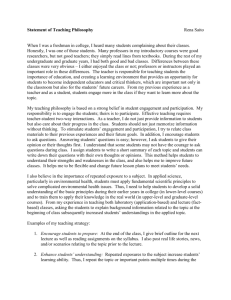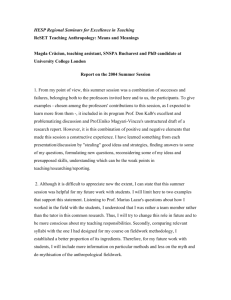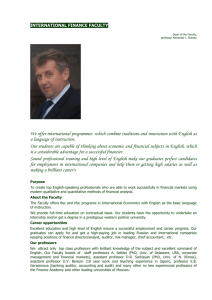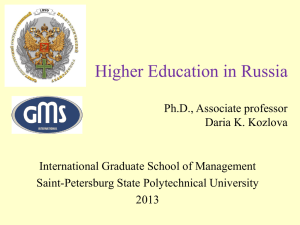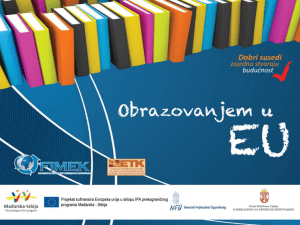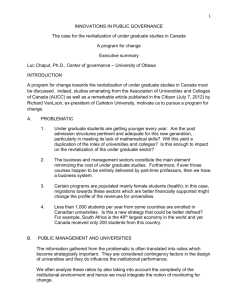SPINE Management Summary - Engineers Shape our Future IngCH
advertisement
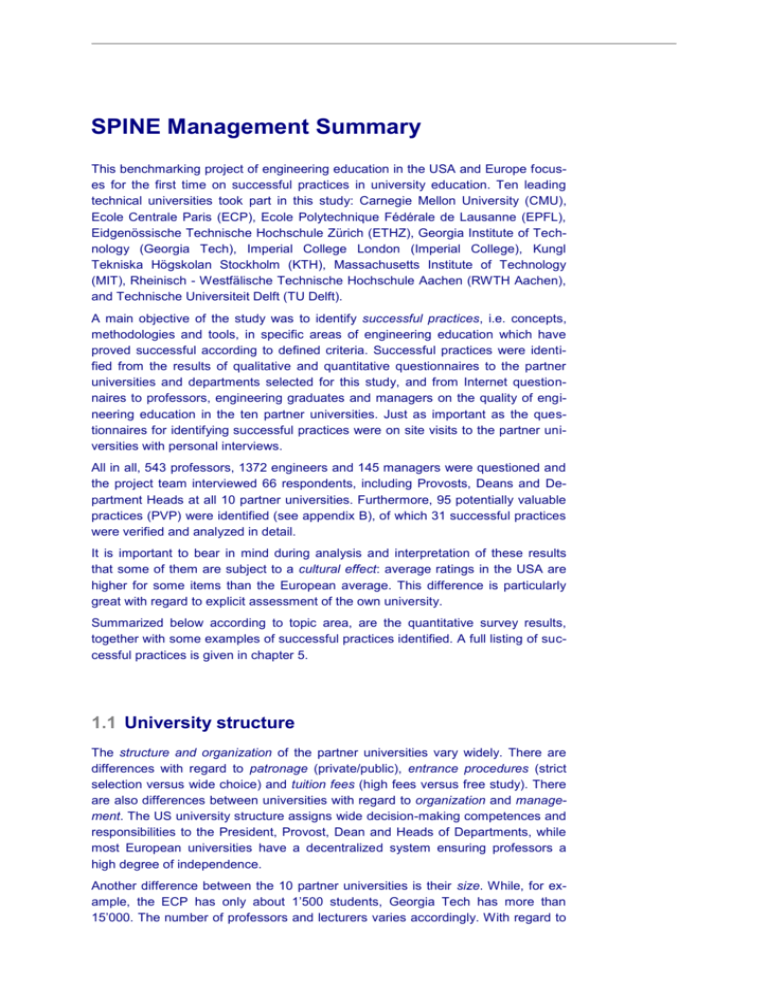
SPINE Management Summary This benchmarking project of engineering education in the USA and Europe focuses for the first time on successful practices in university education. Ten leading technical universities took part in this study: Carnegie Mellon University (CMU), Ecole Centrale Paris (ECP), Ecole Polytechnique Fédérale de Lausanne (EPFL), Eidgenössische Technische Hochschule Zürich (ETHZ), Georgia Institute of Technology (Georgia Tech), Imperial College London (Imperial College), Kungl Tekniska Högskolan Stockholm (KTH), Massachusetts Institute of Technology (MIT), Rheinisch - Westfälische Technische Hochschule Aachen (RWTH Aachen), and Technische Universiteit Delft (TU Delft). A main objective of the study was to identify successful practices, i.e. concepts, methodologies and tools, in specific areas of engineering education which have proved successful according to defined criteria. Successful practices were identified from the results of qualitative and quantitative questionnaires to the partner universities and departments selected for this study, and from Internet questionnaires to professors, engineering graduates and managers on the quality of engineering education in the ten partner universities. Just as important as the questionnaires for identifying successful practices were on site visits to the partner universities with personal interviews. All in all, 543 professors, 1372 engineers and 145 managers were questioned and the project team interviewed 66 respondents, including Provosts, Deans and Department Heads at all 10 partner universities. Furthermore, 95 potentially valuable practices (PVP) were identified (see appendix B), of which 31 successful practices were verified and analyzed in detail. It is important to bear in mind during analysis and interpretation of these results that some of them are subject to a cultural effect: average ratings in the USA are higher for some items than the European average. This difference is particularly great with regard to explicit assessment of the own university. Summarized below according to topic area, are the quantitative survey results, together with some examples of successful practices identified. A full listing of successful practices is given in chapter 5. 1.1 University structure The structure and organization of the partner universities vary widely. There are differences with regard to patronage (private/public), entrance procedures (strict selection versus wide choice) and tuition fees (high fees versus free study). There are also differences between universities with regard to organization and management. The US university structure assigns wide decision-making competences and responsibilities to the President, Provost, Dean and Heads of Departments, while most European universities have a decentralized system ensuring professors a high degree of independence. Another difference between the 10 partner universities is their size. While, for example, the ECP has only about 1’500 students, Georgia Tech has more than 15’000. The number of professors and lecturers varies accordingly. With regard to the number of students, an interesting demographic aspect is the proportion of women, which while traditionally much lower in engineering than in other disciplines, differs considerably between universities. The proportion of women students at Imperial College in the areas surveyed is 18%, at MIT 27%, while at RWTH Aachen and EPFL it is only 7% and 5% respectively. Despite these quantitative differences and the additional cultural and social effects, all the partner universities have one characteristic in common: they are among the best engineering education institutions in their respective countries, or even the best of all. Successful practices: Imperial College is making great efforts to motivate more women to study science and engineering. Since the mid-eighties, IC has been running so-called WISE (Women in Science and Engineering) courses, which are announced in all 4’700 schools in the UK and are a mixture of sessions with undergraduates, discussions with students and staff members, laboratory work and socializing. As a result, the percentage of female students increased between 1985 and 2001 from 16% to 30% (in all disciplines). Some of the SPINE partner universities have introduced sophisticated quality management systems in order to maintain or continuously improve their high training standards. TU Delft has an elaborate external and internal quality management program which works by conducting intensive discussions. The Education Quality Management Advisory Committee for Quality Evaluation (AKO), consisting of professors, students and external members, provides a memory and awareness function for TU Delft’s quality management system. A success factor at MIT comprises so-called external Visiting Committees (VC), which make a decisive contribution to quality assurance. These VCs, each with 18 members, exist for every academic department and provide an independent assessment of the quality of activities conducted by the departments which are visited on a regular basis, typically every 2 years. The ETHZ also has a well-defined internal and external evaluation system, consisting of six modules: peer reviews, departmental self-evaluation, graduate questionnaires, student questionnaires, annual reports, and administration quality surveys. 1.2 Education / Internationality Quality of education Quality of professors/teaching staff and quality of infrastructure are regarded as the most important criteria for the quality of education. Almost as important for engineers and managers is cooperation with industry, while professors regard the practice-related aspects of education (e.g. non-core competences) as less important. More importance is attached in the US to specialization/depth of education than in Europe, where internationality is regarded as more important. In general, engineers rate the criteria for the quality of education at their own university rather lower than professors do. Average ratings by European engineers are lower than those of their US colleagues. The percentage of students spending at least one term at a foreign university is lower among US universities (except Georgia Tech) than in Europe. The highest exchange rates are at EPFL and ECP, where nearly 30% of students spend at least one semester abroad. Successful practices: The importance of internationality in Europe is also reflected in successful practices: in the eighties ECP implemented a long-term strategy for internationality and was one of the founders of the TIME network, a double degree program currently utilized by 34% of ECP students. In recent years EPFL has also undertaken successful efforts on internationalization in research and education, and created a centre for continuing education, international relations and cooperation (CFRC). In addition to the CFRC, EPFL has “mobility delegates” and professors responsible for the individual relationships with foreign universities. ETHZ has a very cosmopolitan and international faculty composition, and offers compensation packages (containing financial and non-financial elements) which are among the most attractive worldwide. Another example is KTH with its international master programs in English in order to increase the number of international and Swedish students. International master programs are also offered at TU Delft. With the new programs in English, TU Delft was able to increase the number of foreign Ph.D. students, to extend its international alumni network and to establish new collaborations with partner universities, e.g. in the US. Teaching methods The most highly rated teaching methods are diploma/final projects. All teaching methods are assessed lower by engineers than by professors, in particular with regard to lectures and computer-based training. Own universities in the US are rated higher than in Europe. This effect is more pronounced among engineers than among professors. Successful practices: Notable here is the Distance Learning / Distance Education program developed by Georgia Tech, a university which has accumulated long-term experience in this area. Important in this connection is the integration of newer technologies such as satellite, teleconferencing, and the Internet. The focus on excellent services for the distance learner is as imperative as the close cooperation of the Center for Distance Learning and the academic units. At KTH, communication aspects, project work and management skills, which are usually taught in courses, are integrated into the more traditional studies at an early stage. For example, education in mathematics has been changed. The math courses are coordinated with an appropriate engineering course in order to increase the motivation of the students. Learning environment The professional competence of teaching staff was rated highest. Support and counselling for students and pedagogical and didactic skills of teaching staff were rated lowest. These aspects were considered by engineers as inadequate (<4, on a scale from 1 - 6; 1=lowest, 6=highest). Infrastructure (tools, student facilities, practical training facilities) was rated on average as fair to good (4.5 – 5). Ratings by engineers are generally lower than those by professors. 1.3 Cooperation with universities / industry Most professors reported cooperation sporadically or regularly with other universities over the last two years. The most frequent form of cooperation is joint R&D projects, and less frequently exchange of lecturers/teachers. The future importance of cooperation with other universities was estimated as same to increasing. There are, however, wide differences between universities. 50 - 80% of professors reported cooperating "regularly" with other universities over the last two years in the form of R&D projects., the highest percentage being among professors at Imperial College (79%), and the lowest among professors at ECP and CMU (52% each). In the professors' view, likewise cooperation with industry is most frequently in the form of R&D projects and less frequently as lectures/teachers from industry. Here again, there are wide differences between the partner universities. Nearly 90% of ECP professors cooperated regularly with industry over the last two years in the form of lecturers/teachers from industry. Likewise, at the ETHZ and RWTH Aachen, more than 50% of professors indicated "regularly". These percentages at MIT, CMU, EPFL and Imperial College are below 30%. The managers questioned indicated cooperation in student and diploma/thesis projects as the most frequent cooperation form. In the view of professors and managers, the various forms of cooperation are generally beneficial to them. Professors rate cooperation with industry slightly higher than cooperation with other universities. Managers see the greatest benefit of cooperation with universities as contact with potential employees. The number of professors with experience in industry varies between 30% and 67%, with lower percentages at the US universities on average. However, two thirds of professors at TU Delft and KTH have no industrial experience at all. Successful practices: ECP has strong links with industry in funding, teaching and research. Teaching partnerships with industry, part-time professors from industry and the creation of a club of multinational companies for international student exchanges are only some of the aspects of the successful university-industry cooperation. EPFL offers courses focusing on the basic sciences, but with strong links to industry. In the first year, students are trained to understand the basics of science and engineering in depth. But every student is required to write a practice-oriented diploma thesis – in a lab at EPFL or in industry (20 – 25% of the students). A special kind of cooperation with industry exists at Georgia Tech, where in the early eighties the Advanced Technology Development Center (ATDC) was founded in cooperation with the State of Georgia. The goal was to create an environment to promote technological entrepreneurship, to build support groups which help the development of technology companies and to strengthen the infrastructure necessary to support technology development. The ATDC helps to build or complete the business plan, understand the markets, and gives technical support to further develop a product. 1.4 Performance of engineers Engineering competences General, widely applicable skills (problem-solving skills, analysis/ methodological skills) are regarded as more important than specific engineering know-how (R&D know-how, specialized engineering proficiency). Specialized engineering proficiency is, however, rated more highly in the US than in Europe. Practical engineering experience is regarded by professors as the least important competence. Engineers and managers, however, regard practical experience as more important. Widely applicable problem-solving skills and analysis / methodological skills are rated the highest of all competences at the own university. There are also general differences in rating levels between universities. Professors at KTH, for example, rated their university's engineering competences at 3.8 to 4.6 (scale 1 – 6; 1=lowest, 6=highest), while MIT professors returned ratings of 4.5 to 5.5. US ratings are generally higher than in Europe, but there are also differences in rating levels between European universities The differences among engineers were more pronounced, with an average rating of engineering competences at RWTH Aachen and KTH of 4.3, compared with about 5 at US universities. Ratings among the US universities are particularly high at MIT and CMU. Successful practices: A particularly interesting successful practice has been established at MIT. Engineering education here is broad, fundamental, yet practical, and influenced by the curriculum, an extensive cooperative program with industry and an industrial connection program to improve MIT’s links with industry. At CMU, an introduction to engineering courses is offered in the first year in parallel with mathematics and engineering, in order to give students experience with actual physical systems as soon as possible in their curriculum. At RWTH Aachen, students are integrated particularly frequently in research. Virtually every student who has passed the pre-diploma examinations works as an auxiliary research assistant. Students perform partial activities for scientific projects and are given small, limited blocks to handle on their own. The selection and continued employment of students as auxiliary research assistants is the most important route for recruiting Ph.D. students. General professional competences Universal, widely applicable competences such as communication skills, English language skills and teamwork abilities are regarded as the most important general professional competences for engineering graduates. Specialized skills in other areas such as law, marketing and finance are not regarded as important in engineering education. Presentation skills / leadership skills are regarded as more important by professors at US universities than by their European colleagues. Among engineers, the only difference between the USA and Europe concerns other language skills, to which US engineers assign an importance rating of only 3 on a scale of 1 to 6. European professors rate the implementation of general professional competences at their own university higher than engineers. The widest differences are in competences such as leadership skills, social skills and presentation skills. The importance of general professional competences is rated >4 (on a scale of 1 to 6) on average, but the implementation of these competences at the own university is rated lower on average (<4). The biggest difference between importance and assessment is with communication skills, leadership skills and social skills. With regard to leadership skills the greatest difference are between the AngloSaxon and other universities. Engineers and Professors at MIT, CMU, Georgia Tech and Imperial College rate their leadership skills between 4 and 5 on a scale of 1 to 6, while ratings at the other European universities are below 4. One exception here is ECP, with above-average ratings for Europe. With regard to social skills, there is a difference between the views of professors (ratings >5) and engineers (<5). The highest ratings among professors are at ECP, KTH, Imperial College and TU Delft. Successful practices: Imperial College integrates project work and teamwork extremely well. Integrated laboratories where computing is purposely set up as an engineering and not as a scientific discipline, groupwork starting in the 1st year and continuing throughout the 2nd year, and interaction between laboratories and groupwork are some of the components of this successful practice. CMU has established interdisciplinary and team projects in order to ensure that courses offer a realistic design experience by associating every project with an actual industrial client. Another objective of CMU’s education concept is to motivate students to document their results. 1.5 Reputation of universities Quality of research, quality of programs and success of graduates are regarded as the most important aspects contributing to the reputation of a technical university. Ranking by the media and continuing education programs are regarded as less important. In the view of engineers and managers, contacts/collaboration with industry are among the most important image forming factors for a university. Professors regard this aspect as less important. Merits, awards (e.g. Nobel prize) and publications by professors are much more important in the view of professors than of engineers. Performance-related criteria such as merits/awards for professors, ranking by the media, publications by professors and success of graduates are regarded as more important in the USA than in Europe. The reputations of partner universities are rated with average values between 4.2 and 4.9 on a scale of 1 to 6. Exceptions are ETHZ and MIT, where ratings are higher than 5. Professors and engineers rate their own universities above-average in each case. This particularly applies to engineers in the United States. European professors and engineers (such as at KTH and RWTH Aachen) rate their own universities rather modestly by comparison.

